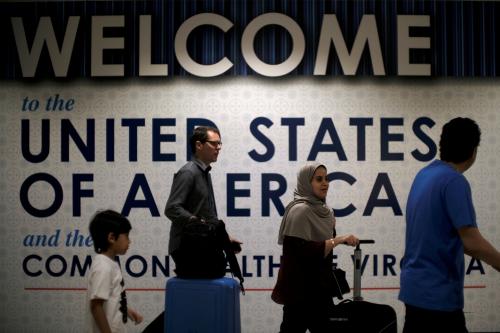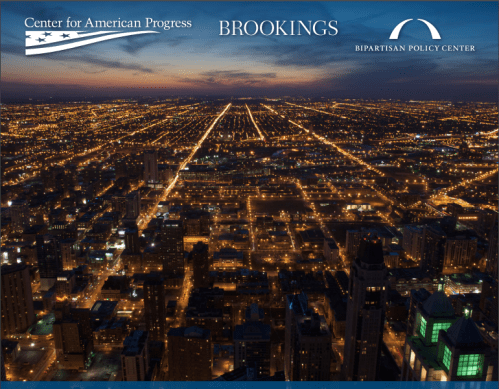Now eight years since the end of the Great Recession, and with the economy coming back, the U.S. Census Bureau’s new statistics about migration within the U.S. are surprising. The new data show a nation that continues to be heavily stuck in place. This illumination resonates from a census Current Population Survey historic time series that ends with moves occurring in 2016-2017 and shows the following three key points:
Annual movement within the U.S. is stuck at a postwar low rate of 11 percent. This 2016-2017 rate is not statistically different than the 11.2 percent rate of 2015-2016, the lowest mobility rate in any year since this annual series began in 1947-48 (see Figure 1). The decline in annual mobility rates, from over 20 percent during some years in the 1950s and 1960s down to almost half that today, is the result of long term trends, such as the aging of the population (older people move less than younger people) and rises in homeownership (owners move less than renters). Yet the downward mobility trend of the last decade can certainly be tied to the lasting effects of the Great Recession and housing bust which occurred over the 2007-2009 period.

Most of the recent mobility decline is due to local moves rather than longer distance moves. To help understand why overall mobility remains low, it is useful to know that most moves–about three-fifth–are local moves that occur within county boundaries. It is primarily these moves that have driven down the overall mobility rate. Just as the total mobility rate has hit an all-time low of 11 percent, the within county mobility rate reached an all-time low of 6.8 percent in 2016-2017.
Yet, longer distance inter-state migration rates picked up slightly over the past two years. This is important to note because unlike local, within county moves – which are largely driven by housing and life course changes (i.e. leaving parental homes, getting married, having children) – longer distance inter-state moves are more greatly influenced by jobs and labor market draws.
Both short distance and long distance mobility took a dive after the Great Recession (see Figures 2a and 2b). However, the recent decline of local moves suggests that a series of forces affecting young people, such as high college debt, delays in leaving parental homes to establish their own, and financial barriers to homeownership, may have kept them especially stuck in place. The fact that renters, in particular, showed a strong mobility decline could reflect a rental market that, as my colleague Jenny Schuetz points out, has become especially out of reach to low and middle income households.

Millennials show stagnant local mobility but rising long distance migration. A focus on “older millennial” adults, currently ages 25-34, is significant because they make up a disproportionate share of adult movers (34 percent of movers compared with 18 percent of the adult population) and their moves tend to be more permanent than those of adults below age 25. Moreover, this allows a focus on the older segment of the millennial generation, which has been hit hard by the recession and housing crunch.
The new data show that these millennials share the overall pattern of local mobility stagnation. Their recent within county migration rates of 12-12.4 percent from 2005-17 are the lowest since at least the mid-1990s when adults of this age moved in the 16-17 percent range and stood at 15 percent as late as 2009-10. Yet what is new is a noticeable uptick for inter-state migration for this group, rising to 3.3 percent – a level not seen since 2005-2006 (see Figure 3).

This suggests that the recent rise in employment is prompting more millennials to move long distances toward rapidly growing parts of the country. Although the inter-state migration rate of millennials over the last year still remains well below rates exceeding 4 percent during the 1990s, it does suggest a positive response to recent economic growth. This is also consistent with the re-emergence of aggregate migration flows to the Sun Belt and smaller metropolitan areas that existed prior to the recession.
America continues to “stay put,” owing largely to the continued reticence to make local moves
These data trends indicate that there could be a long awaited return to more healthy pre-recession movement across states and labor markets, especially for millennials. Still, overall, America continues to “stay put,” owing largely to the continued reticence to make local moves. Millennials are central to this trend, as well, be it due to economic explanations, housing factors, or, for many, a continued “failure to launch.” Perhaps, as with long-distance migration, local movement will eventually pick up as the housing market revives further, as millennials make “catch-up” moves and as the post-millennial generation follows more traditional patterns. It is a trend worth following for a nation that has long been one of the world’s most mobile. (1)
(1) Tony Champion, Thomas Cooke and Ian Shuttleworth (eds), Internal Migration in the Developed World: Are We Becoming Less Mobile?” (New York, Routledge, 2018)
The Brookings Institution is committed to quality, independence, and impact.
We are supported by a diverse array of funders. In line with our values and policies, each Brookings publication represents the sole views of its author(s).






Commentary
U.S. migration still at historically low levels, census shows
November 20, 2017